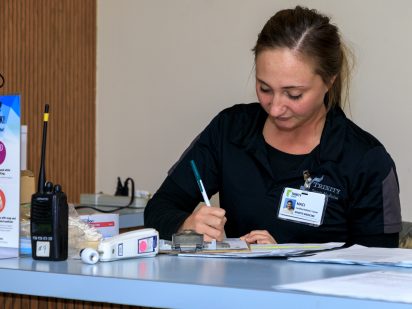March is National Athletic Training Month, a time dedicated to spreading awareness about the important work of athletic trainers. This year, the slogan is “Essential to Health Care” … and how right they are!
At the beginning of the COVID-19 pandemic, Trinity Health’s athletic trainers started a new role when they reported to the hospital’s labor pool to see where they needed assistance, explained Robyn Gust, manager of the Sports Medicine department. Athletic events at Minot State University had come to a halt, and slowly, there was a trickle effect on other games in the region, leaving the department with time on their hands. “We were in the labor pool right away, which was helpful to the organization,” Gust added. “Athletic trainers were answering labor pool phones, doing screenings at the doors, or any other tasks that were needed.”
Athletic trainers “jumped in and helped out whenever and wherever they were needed within the facility during those months of labor pool,” explained Sara Abrahamson, recruitment supervisor of Trinity Health’s Human Resources and co-organizer of the labor pool. “Sometimes they worked overnights, weekends, and various other times. They were reliable and without them, it wouldn’t have gone as smoothly. They were more than willing to help out and jump in whenever they were needed.”
Then, when COVID drive through testing was being done and COVID positive cases were higher, athletic trainers helped nurses, making sure they had what they needed and at the same time, helping with administrative needs – checking IDs, getting information, etc. – so the nurses “could swab the patient and get through the 200 cars in the two hours we were at during high numbers for a bit,” Gust said. “The role that we had to take on was such an unusual, expansive role. It was something you would never imagine in your wildest dreams you would do.”
The role of the certified athletic trainers in an organization like Trinity Health has come full circle. Primarily, sports have been number one of the list of priorities, but at a time when there were no sports, taking part in testing people during a pandemic was a thing “you never ever thought would be a part of your profession” but is now “a part of your daily routine,” Gust said.
This past autumn, when the school year began, and high school sports were back in session, the athletic trainers were ready. They had developed “COVID-safe” versions of their Summer FASTER program, an injury prevention program for high school student athletes. “We came up with a plan to get our athletes ready for activity but maintain a safeness that was necessary for them to do what they needed to do,” Gust said. “We had to come up with creative ways to train athletes in a safe, socially distanced, hygienic way. We had to think outside the box to challenge them and get them ready for sports but keep them safe and protected from COVID-19.”
Gust said that while working with student athletes at Our Redeemer’s, “In the past, I would have 18 or more kids in a session. We ran it with eight, with their own 10-foot square space.” While working with schools, the athletic trainers helped them get protocols in place before school even started.
“We did what needed to be done to make sure everyone was taken care of,” Gust said. “We always wear many hats; we just never thought our hat collection would be this extensive.”
In the athletic training rooms, the atmosphere was different. “Normally, we would see eight people at the same time and not bat an eyelash,” Gust said. However, the number of people – athletes and staff – had to be limited to ensure that social distance was maintained. “We really had to streamline that to make if efficient and to make sure we were following guidelines to keep people safe.”
The year 2020, as well as the beginning of 2021, has “been a year like no other in sports, as well as athletic training,” Gust said. “It has shown people outside of the sports world that certified athletic trainers are definitely ‘Essential to Healthcare.’”

